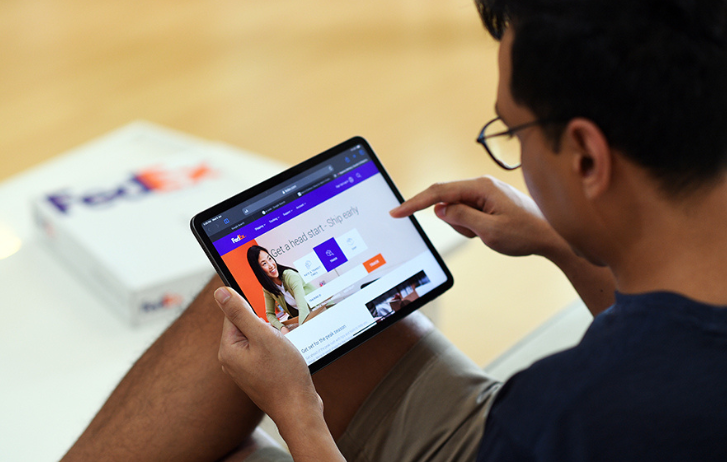
How To Streamline E-Commerce Delivery: 5 Proven Strategies For Small Businesses
By Kawal Preet | First published: September 6, 2021 Updated: July 10, 2025
Fast, efficient e-commerce delivery is the key to growth. Here are five proven strategies to streamline online order shipping and delight your customers.
- Automating shipping workflows and using near-real-time data can reduce errors, speed up order fulfillment, and help small businesses scale efficiently.
- Optimizing packaging and offering flexible delivery options improves both cost-effectiveness and customer experience.
- For cross-border e-commerce delivery, simplifying customs processes and using e-commerce delivery services like FedEx International Connect Plus (FICP) can reduce delays and boost your global reach.
E-commerce continues to grow in Asia-Pacific and beyond. With the APAC e-commerce logistics market expected to surpass USD 701 billion by 2030, it’s critical for businesses to streamline their e-commerce delivery.
More than just the final step of a transaction, delivery is a key driver of customer satisfaction and repeat business. Failing to optimize your e-commerce delivery can mean losing customers to competitors.
However, for many small and medium-sized enterprises (SMEs), managing e-commerce deliveries, especially across borders, can be a significant source of stress. From customs compliance to rising shipping costs, the logistics of online order fulfillment can quickly become complex.
Whether you’re scaling up or just getting started, here are five actionable strategies to streamline your e-commerce delivery process, reduce friction, and keep your customers happy.
1. Automate your shipping workflows
Manual processes may work for a handful of orders, but as your volume grows, they’ll hold your business back. Automating your shipping operations helps speed up order processing, reduce human error, and ensure consistency. In fact, digitizing mid- and last-mile logistics handovers not only prevents delays and reduces waste, but also helps avert billions in losses per year.
You can use integrated shipping tools, like FedEx Ship Manager, which allows you to create labels, schedule pickups, and track deliveries all in one place. You can also connect your FedEx account directly to your e-commerce platform to create bulk labels, automatically generate commercial invoices, and synchronize tracking.
For added customer satisfaction, use tools like FedEx Delivery Manager to provide your customers with greater visibility and control over their shipments.
2. Right-size your packaging to reduce waste and costs
E-commerce companies now face vast packaging challenges. On one hand, the global e-commerce packaging market size is expected to grow from USD 49.7 billion in 2023 to USD 86.9 billion by 2030. On the other hand, there’s increased demand for more sustainable packaging. To stay ahead, e-commerce companies must make significant changes.
Packaging can make or break both your brand impression and your bottom line. Oversized or inefficient packaging increases your shipping costs and carbon footprint, especially for international deliveries.
Start by right-sizing your packaging for each product type. Consider sustainable alternatives, such as recyclable or biodegradable materials, and explore branded packaging options to enhance your unboxing experience. You can also take advantage of FedEx’s packaging solutions, including our Reusable Pak, to find the best options for protecting and shipping your goods.
3. Use data to forecast demand and reduce delays
Shipping delays are often the result of poor planning. By using data analytics, you can forecast demand more accurately, optimize inventory preparation, and manage seasonal surges more effectively.
Near-real-time data from tools like FedEx Surround can help you proactively monitor risks, such as weather disruptions and potential delivery delays, for your high-value, time-sensitive shipments. This gives you better control over your operations and lets you respond before problems escalate. For SMEs, this kind of predictive insight can help level the playing field, enabling you to deliver results comparable to those of bigger players.
4. Simplify customs and cross-border shipping
Cross-border e-commerce offers massive growth potential. From USD 50.8 billion in 2024, the cross-border e-commerce logistics market in Asia Pacific is expected to reach USD 213 billion by 2030. However, customs paperwork, tariffs, and compliance can be a minefield for small businesses.
To streamline the process, consider working with a logistics provider that specializes in international shipping and offers customs support. For example, FedEx International Connect Plus (FICP) is an e-commerce delivery service designed for flexibility and speed, connecting your business to customers worldwide with day-definite delivery, end-to-end tracking, one simple rate structure, and customer clearance. With recent updates to FICP, Asia Pacific e-tailers can now easily ship to key destinations in the US and Europe within two to three business days.
5. Stay flexible to meet customer expectations
It used to be that products were the focus of an effective e-commerce strategy. Now, it’s all about the customer experience, from browsing products online to receiving items at their doorstep. And today’s customers want more options, from express shipping to eco-friendly delivery.
Offering flexible delivery services can help your business stand out. Give your customers a choice of shipping speeds and costs, clearly communicate delivery timelines, and consider offering features such as estimated delivery dates and free shipping thresholds.
As you grow, look for ways to build agility into your supply chain so you can pivot quickly, whether to meet spikes in demand or navigate regulatory changes.
Ready to take your e-commerce delivery global?
Beyond moving packages, efficient e-commerce delivery is about creating seamless customer experiences and building long-term loyalty. By streamlining online order shipping with the right tools and strategies, SMEs can save time, cut costs, and scale with confidence.
***
Explore FedEx’s shipping services today to see how we help businesses like yours deliver smarter, faster.
SHARE THIS STORY
- 85% Of APAC Businesses Plan To Expand Into Europe, According To New FedEx Report
- Generative AI: A New Frontier
- How To Ship A Giant Panda
- The Rise Of Intra-Asia Trade: Opportunities In The China-Southeast Asia Corridor
- Where Do Old Planes Go When They Retire?
- What’s So Dangerous About Coconuts? Your Guide To Dangerous Goods Logistics
Sign up now and save on your shipping rates!
Sign up now and earn discounts by shipping instantly with FedEx Ship ManagerTM at fedex.com.
Recommended For You

How To Keep Your High-Value Shipments Safe And Secure
Here’s how your business can prevent costly damage and ensure safe, on-time delivery.
Read More
How To Expand Your E-Commerce Business In 5 Key Steps
A successful market expansion strategy relies on meticulous research into market complexities, customer demand and operational readiness.
Read More
How To Get Better Value When Shipping Cross-Border
When choosing international shipping options, SMEs and e-tailers consider cost and speed. Find out which FedEx service is best for your business.
Read More

